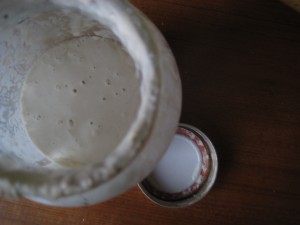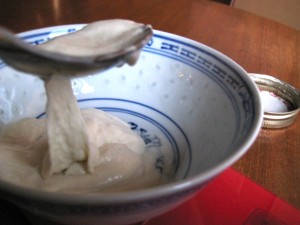Is it time for another bread post? Of course it’s time for another bread post, and thus, I present to you, the Concise and Incomprehensive Guide to Care and Maintenance of Your Sourdough Starter.
Start!
I used Peter Reinhart’s pineapple juice method, however, mixing together flour and water and setting it on the counter is enough.
I keep my sourdough starter at 100% hydration for a couple reasons: the first being that it simplifies calculations, such as if I’m adapting a particular recipe to sourdough and want to maintain the same formula. Secondly, having a wet sourdough starter rather than one at the consistency of bread dough makes it much easier to feed; you can stir rather than knead in additional flour and water.
A quick summary of baker’s math is probably in order. Percentages are useful in a number of ways: depending you can adjust hydration as necessary for your desired bread, instantly predict how a particular recipe will turn out, and convert a formula to any quantity you so desire.

Care and maintenance of your starter
Typically you want to double your starter with every feeding. You might also want to triple or quadruple it, but I find myself usually with too much, not too little. Needless to say, add an equal mass of water and flour.

The degradation of your starter
Feeding once a week is the attainable goal for most casual bakers—but even after a week your sourdough starter is noticeably less active, and will likely have collapsed (unless it’s mine, in which case you cannot even tell if it’s alive).
Two weeks, it will still be fine, only turning soupy as the gluten begins to be consumed by the yeast, after most of the starches and sugars are gone.
A month, the layer of pale-yellow alcohol forming on top will become apparent.
Another two months more there will be a thick layer of alcohol on top, and likely some mould lining the inside of the jar and on the surface. The starter itself, below all the mould and anaerobic fermentation byproducts will be completely flat and thin, and may have turned slightly grey.

Reviving your starter
Empty out the jar, preserving, in some manner or other, what you believe has probably not had contact with the mould, separately. Wash out the jar thoroughly, then return the starter, now at least quadrupled or more in weight with new flour and water. Allow it to sit out for a day to get it started again, before returning it to the back of the fridge for another couple of months.
Through personal experience, I’ve found sourdough starters to be very forgiving in this manner.
A third part to this bread series will be coming—and perhaps this time it will actually be about making bread?

